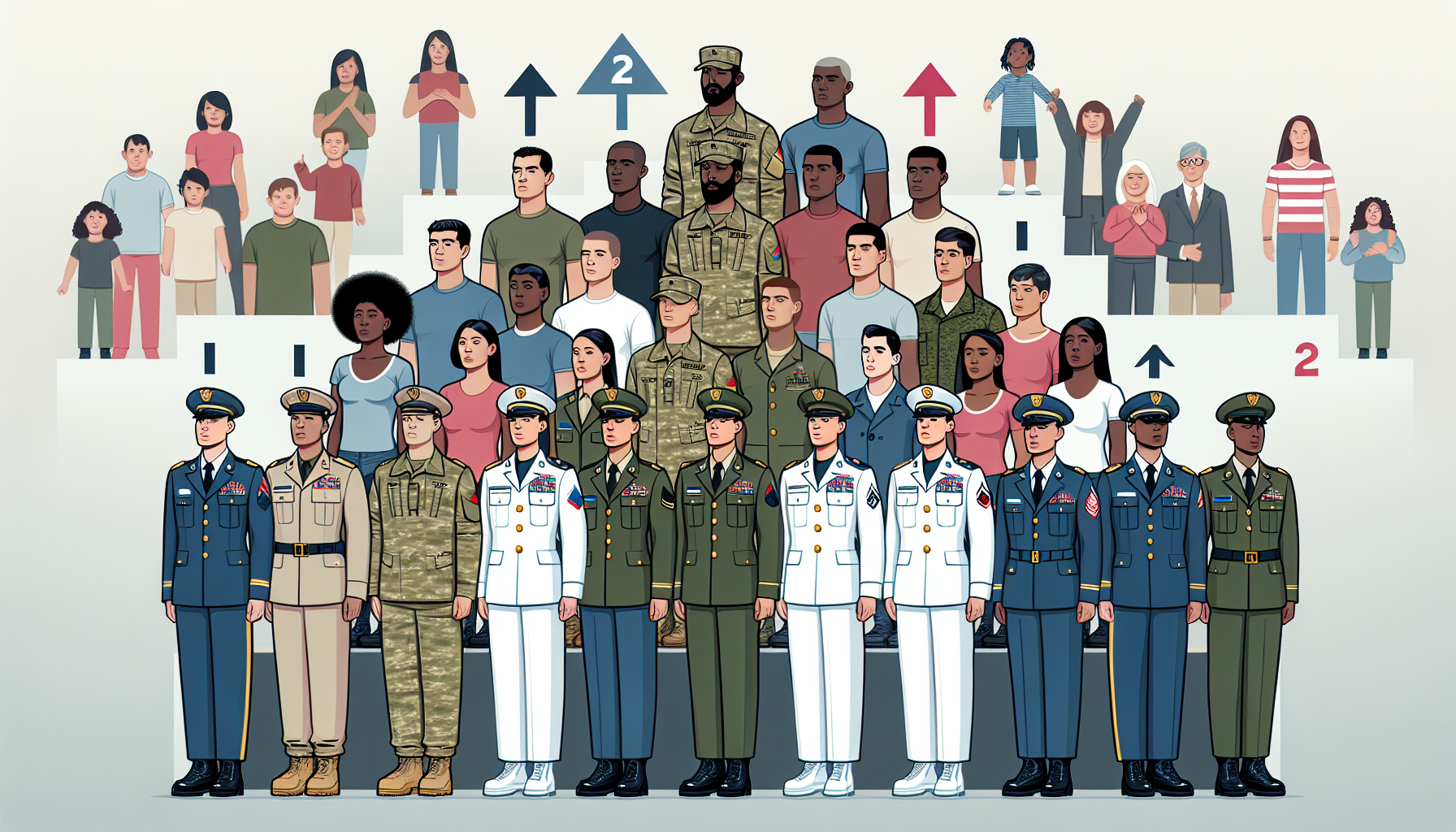Definition
The term “chain of command” refers to the hierarchical structure within a military organization, where authority and responsibility flow from higher-ranking officers to lower-ranking personnel. It ensures that orders, decisions, and information are communicated effectively and consistently through the appropriate channels. This system maintains order, discipline, and accountability in the armed forces.
Key Takeaways
- Chain of command refers to the hierarchical structure within a military organization, governing the relationships between different officers, units, and personnel based on their ranks and responsibilities.
- The purpose of a chain of command is to ensure clear communication, control, and coordination in military operations, allowing for efficient decision-making and execution of orders from higher-ranking officials to subordinates.
- A well-defined chain of command is essential for maintaining discipline, accountability, and performance within the military, as it defines the roles and responsibilities of each individual and establishes the proper channels for resolving issues or conflicts.
Importance
The term “chain of command” is crucial in military operations as it establishes a clearly defined hierarchy of authority, communication, and decision-making within an organization.
This structure allows for efficient coordination, discipline, and communication across various levels of personnel by ensuring orders and decisions come from a single source and are followed accurately.
Additionally, the chain of command prevents confusion and conflict in crisis situations by streamlining decision-making and promoting accountability amongst different ranks.
In essence, the effectiveness and success of military operations largely depend on the smooth functioning of the chain of command, ensuring rapid responses to combat situational challenges while maintaining order among the troops.
Explanation
The chain of command is an integral aspect of military operations and serves to maintain order and unity among personnel. It provides a hierarchical structure through which orders are given, responsibilities are assigned, and tasks are coordinated efficiently.
The primary purpose of the chain of command is to ensure that decisions and directives from higher authorities are communicated and executed in an orderly manner at all levels within the armed forces. This organization strategy allows for swift, clear communication and steers the actions of the many disparate units within the military towards a shared goal with precision and cooperation.
Additionally, the chain of command is essential for maintaining discipline, accountability, and overall operational effectiveness. By delineating clear lines of authority, it helps to prevent confusion and conflicts among units or individuals, who know exactly to whom they report and from whom they receive orders.
This structure also fosters the professional development of military personnel, as it highlights opportunities for growth and promotion through the ranks. Furthermore, in high-stress and high-risk situations, the chain of command is vital for rapid decision-making, as it eliminates ambiguity in the execution of orders and ensures that each individual understands their specific role within the broader operational context.
Examples of Chain of command
Operation Neptune Spear (2011): This operation, also known as the mission to capture and kill Osama bin Laden, demonstrated the crucial role of a clear chain of command in highly sensitive military operations. The mission was led by the U.S. Naval Special Warfare Development Group (SEAL Team Six) under the command of their direct leaders, who coordinated with higher-ranking officials in the CIA, the Pentagon, and the White House. Ultimately, President Barack Obama, as the Commander-in-Chief, authorized and oversaw the operation, ensuring that every decision made throughout the mission adhered to a clear hierarchy.
The Battle of Midway (1942): This pivotal naval battle during World War II exhibited the chain of command between the United States Navy and the Imperial Japanese Navy. Admiral Chester Nimitz, Commander-in-Chief of the U.S. Pacific Fleet, was responsible for overall strategic planning and coordination of forces in the region. He delegated the execution of the battle, including aircraft and ship deployment, to subordinate admirals and officers. On the Japanese side, Admiral Isoroku Yamamoto was the Commander-in-Chief of the Combined Fleet, with his subordinate officers responsible for the various task forces in the battle. Both navies relied on their respective chains of command to coordinate actions, plan attacks, and respond to changing circumstances during the engagement.
Operation Desert Storm (1991): As a part of the Gulf War, the U.S.-led coalition against Iraq showcased the chain of command, both within the U.S. military and among multinational forces. President George H. W. Bush, as Commander-in-Chief, authorized the operation with the support of a United Nations resolution. General Norman Schwarzkopf Jr. served as the Commander of the Coalition Forces, overseeing both U.S. and international military units. Throughout the operation, a clearly defined chain of command was maintained, allowing for essential communication and coordination among the various ground, air, and naval forces during the conflict.
FAQ – Chain of Command
1. What is the chain of command in the military?
The chain of command is the line of authority within an organization, like the military, that establishes a clear hierarchy for communication, responsibility, and decision-making. It defines the relationships between different ranks and positions, ensuring that orders and information are relayed effectively and appropriately.
2. Why is the chain of command important?
The chain of command is crucial for maintaining order and discipline within a military organization. It ensures that all members of the organization understand their respective roles and responsibilities, creating a structure for communication and decision-making that minimizes confusion and enhances the military’s ability to complete its missions and objectives.
3. How does the chain of command work?
The chain of command works by organizing military personnel in a hierarchical structure, with each member reporting to and receiving orders from their direct superior. This structure typically begins with the highest-ranking officer and descends down to the lowest-ranking enlisted personnel. The chain of command provides a pathway for the transmission of orders, information, and decisions throughout the organization, ensuring that everyone is working together as a cohesive unit.
4. Can a lower-ranking member communicate directly to a higher-ranking member?
While the chain of command primarily relies on communication between immediate superiors and subordinates, there may be situations in which a lower-ranking member must communicate directly with a higher-ranking member. However, this is typically an exception rather than the norm and is often reserved for urgent or time-sensitive information that cannot be relayed through the normal channels.
5. What happens if someone violates the chain of command?
Violations of the chain of command can result in a breakdown of communication and order within an organization, leading to inefficiency, confusion, and potential mismanagement. In the military, violating the chain of command is considered a serious offense that can lead to disciplinary action, including potential loss of rank, fines, or other penalties depending on the severity and consequences of the violation.
Related Military Operation Terms
- Military Hierarchy
- Authority Structure
- Leadership Levels
- Command Structure
- Superior Officers
Sources for More Information
- The Library of Congress: The Library of Congress is one of the largest libraries in the world and houses a wide range of resources, including books, documents, and articles on military topics such as chain of command.
- Department of Defense: The U.S. Department of Defense is a key source for military information, including chain of command structures within the United States military branches.
- Joint Chiefs of Staff: The Joint Chiefs of Staff website contains information on the highest-ranking military officers who are responsible for coordinating military operations and maintaining the chain of command within the U.S. Armed Forces.
- Encyclopedia Britannica: Encyclopedia Britannica is a reliable source for information on various topics, including military history and the concept of the chain of command within military organizations.
 Benefits.com Advisors
Benefits.com Advisors
With expertise spanning local, state, and federal benefit programs, our team is dedicated to guiding individuals towards the perfect program tailored to their unique circumstances.
Rise to the top with Peak Benefits!
Join our Peak Benefits Newsletter for the latest news, resources, and offers on all things government benefits.





















